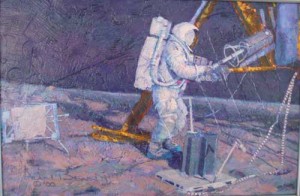Alan Bean
Alan LaVern Bean 1932 - 2018 was born in Wheeler, Texas. After receiving a B.S. degree in aeronautical engineering from the University of Texas, he entered the military, serving as both a fighter pilot and a Navy Test Pilot. After being selected by NASA in 1963, several years of training and waiting followed until Bean was selected for Apollo 12. He landed on the surface of the moon in November of 1969. Although he continued working for NASA for many years afterwards, he retired in 1981 to devote the rest of his life to his other love, painting.
Preparing to Pull to Plutonium - Acrylic on Board 2000 - 2001
Is an original work of Alan Bean that encapsulates the calmness of space and the tenseness of the mission. As quoted from Bean
Here I am on the ocean of storms. My cuff check list indicates that it is time for me to pull our plutonium fuel element out of its graphite cask and place it inside the Snap 27 Electrical Generator. This should be a “Snap” as I’ve practiced the procedure in training back on planet Earth many times without any problems.
I cannot be careless with the plutonium though, because even using this special handling tool the plutonium is super hot, hot enough to melt through my pressure suit if it were to touch it long enough. Not really a good idea unless I want to spend the next few billion years up here on the ocean of storms.
First I take the tool and turn the handle on the near end counterclockwise. This will cause the three metal fingers on the far end to spread out wide so I can place them around the end of the fuel element. Okay… the fingers (each with a little pin attached) are lined up with the holes in the fuel element. Now I hold the tool steady with my left hand and then turn the handle clockwise. The fingers are moving in. I adjust the alignment… keep turning. Careful, I've got to be careful and gentle in these clumsy gloves because if I break off a metal finger or pin the plutonium will stay locked inside the cask and there will be no power for our ALSEP Experiments. There, the pins are locked in, the locks are disengaged, and I'm ready to remove the element. It looks like all is going according to plan, the hard part is complete… At Least I think so!
The International Museum of Art has been lucky enough to sponsor Bean as a guest speaker in El Paso and to receive the painting Preparing to Pull the Plutonium. Many of his works are based on his own first-hand experiences in outer space. Still, he values his artistic license. “If I were a scientist painting the moon, I would paint it gray. I’m an artist, so I can add colors to the moon.” Bean is quoted as saying.
What's that Texture?
Alan Bean would use a bronze replica of his astronaut boot to stamp his paintings.
He would also use a hammer to texturize his paintings. It is the same one he had once used to hammer a flag into the Moon.
The circles were created by hammering in a piece of a metal core tube that was once driven into the Moon's surface.
To The Moon and Back
After his mission Bean was given the patches from his astronaut suit. The patches gathered moon dust from his mission.
Bean would use this moon dust by sprinkling it onto his paintings.
He would also use pieces of fabric from the patches, and pieces from the Apollo 12 spacecraft in his paintings.

